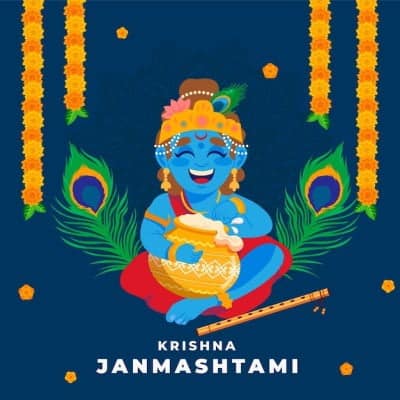Today, we are sharing 10 lines on Janmashtami in English. This article can help students who are looking for information about 10 lines on Janmashtami. This Lines is very simple and easy to remember. The level of these Lines is moderate so any student can write on this topic.
This article is generally useful for class 1,class 2,class 3,class 4,class 5,class 6,class 7,class 8,class 9,class 10,class 11,class 12
10 lines on Janmashtami
1) Janmashtami is a joyous festival celebrated by Hindus to honor the birth of Lord Krishna, who is considered a divine and beloved figure.
2) It is an opportunity for students to learn about Indian culture and mythology, as they delve into the stories and teachings associated with Lord Krishna.
3) Students can participate in school events and competitions like drawing and painting competitions, fancy dress competitions, and storytelling sessions centered around Lord Krishna’s life.
4) Janmashtami teaches students the values of devotion, righteousness, and compassion through the life and teachings of Lord Krishna.
5) Students can engage in creating beautiful decorations for their classrooms or school premises, using vibrant colors and traditional motifs.
6) This festival encourages students to showcase their talents through dance performances, music recitals, and drama depicting the various episodes from Lord Krishna’s life.
7) Students can also participate in the Dahi Handi activity, where they form human pyramids to break the pot filled with curd or butter, promoting teamwork and physical fitness.
8) Janmashtami provides an opportunity for students to understand the significance of fasting, self-discipline, and self-control as they observe fasts or make simple offerings to Lord Krishna.
9) Through Janmashtami celebrations, students can foster a sense of unity and harmony by embracing cultural diversity and learning about different traditions and practices.
10) Janmashtami serves as a reminder for students to embrace Krishna’s teachings of love, wisdom, and righteousness in their lives and strive to become responsible and compassionate individuals.

5 lines on Janmashtami
1) Janmashtami is a Hindu festival celebrated to honor the birth of Lord Krishna, an avatar of Lord Vishnu.
2) It is observed on the eighth day (Ashtami) of the Hindu month of Bhadrapada, usually falling in August or September.
3) Devotees engage in fasting, prayer, and devotional singing to celebrate this auspicious occasion.
4) Temples and homes are adorned with colorful decorations, and the deities of Lord Krishna are beautifully adorned.
5) Janmashtami serves as a reminder of Lord Krishna’s teachings and inspires devotees to lead a life of righteousness and devotion.
FAQ
Answer: Janmashtami commemorates the birth of Lord Krishna. According to Hindu mythology, Lord Krishna was born in Mathura to Devaki and Vasudeva. Due to a prophecy that he would be killed by Devaki’s brother, King Kansa, Krishna was secretly taken to Gokul and raised by Yashoda and Nanda. The festival celebrates his divine presence on Earth and his teachings.
Answer: Janmashtami is celebrated with great enthusiasm and devotion. Devotees observe fasts and engage in prayers, bhajans (devotional songs), and kirtans (sacred chants). Temples are adorned with decorations, and the idols of Lord Krishna are beautifully dressed. Many people participate in cultural performances such as dances, dramas, and skits depicting the life and leelas (divine plays) of Lord Krishna.
Answer: During Janmashtami, devotees often keep a vigil through the night, as it is believed that Lord Krishna was born at midnight. They offer prayers, perform aarti (ritual of worship with lighted lamps), and sing hymns in praise of Lord Krishna. Dahi Handi is another popular ritual where a pot filled with curd or butter is suspended at a height, and participants form human pyramids to reach and break it. This ritual symbolizes Krishna’s love for butter and his mischievous nature during his childhood.
